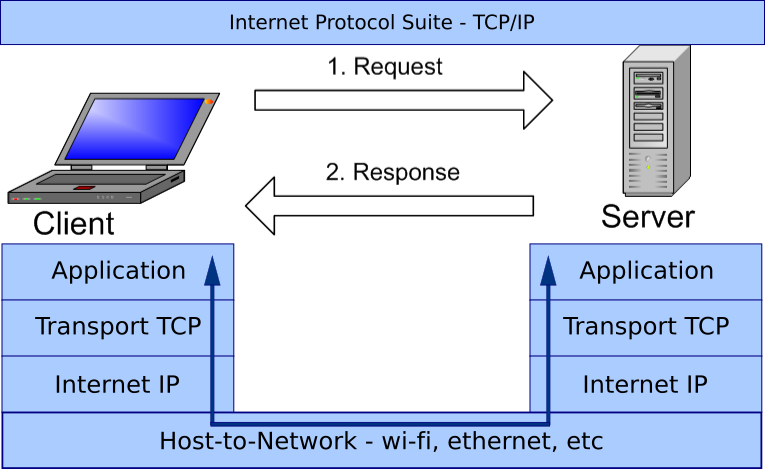The Internet Layers
If you ever tried to understand how your computer connects to the internet, you probably learned that a client — usually, but not always, a browser — sends a request to a server, located at the address you typed in in the browser’s address bar; then the server sends back a response to the client. That’s is pretty accurate. But there is much more to that.

It is possible to describe how that connection happens — what goes behind the arrows showing the request and response process — in many ways. This post will focus on the layers traversed by requests and responses in the Internet Protocol Suite (TCP/IP - Transmission Control Protocol/Internet Protocol).
Layer by layer
The layers are are organized in such a way that one only communicates to the other immediately before or after. So, if we had 3 layers, this would be what would happen:
|---------| -----> |---------| -----> |---------|
| layer 1 | <----- | layer 2 | <----- | layer 3 |
|---------| |---------| |---------|
Layer 1 talks to Layer 2; Layer 2 talks to 1 and 3, and Layer 3 talks to 2.
Each layer follows certain protocols that allow them the communicate and exchange the data between each other.
The TCP/IP has 4 layers and this is how it goes:
-
The application layer: The application client
The application layer on both sides — client and server — is responsible to follow the HTTP protocol, that establishes a set of rules that client and server use in order to be able to communicate with each other. The HTTP protocol is not the only one that must be handled at the application layer. There are SMTP, FTP and others.
Assuming that the client makes a GET request following the HTTP Protocol, the data that is going to be passed to the next layer will hold all the information necessary to establish the communication with the server. It will have a header containing the method (GET), the request URI, which version of the HTTP Protocol it uses etc.
The application layer writes the data to the stream and passes it to the transport layer.
-
The transport layer (TCP): Break the data into smaller parts and identifies them
The transport layer reads the data from the stream, breaks the request in smaller chunks (TCP segments) and give each one a number and a checksum (an unique identifier that is checked to see if the data was corrupted or not).
While researching about the TCP/IP model, I have seen articles saying that the transport layer turns data into packets (IP datagrams) and that the internet layer only sends them out. Other articles state that the transport layer breaks the data into TCP segments, that then are turned into even smaller chunks (packets) in the internet layer. I decided to use the second explanation, because that is how it is described in Java Network Programming.
-
The internet layer (IP): Create and dispatch packets
The IP layer gets those chunks of data (TCP segments), breaks them into packets (IP datagrams) and passes them to the next layer. This is where data is addressed and routed.
An IP datagram holds the IP addresses of the sender and the receiver, the payload data, its size, and other information. There are two versions of how this information is organized: IPv4 and IPv6, the difference being the byte size of the IP addresses (32 vs 128 bytes). The IPv4 was exploited recently in an attack that put down popular websites around the world.
-
The host-to-network layer: The internet
Here is where the data travels from one device to another, the physical transportation of the data.
-
The internet layer: Receive packets
This time, the internet layer reassembles the packets if they eventually got fragmented and make some checks to see if the they were corrupted. It then passes the packets to the next layer.
-
The transport layer: Reassembles packets
The server transport layer now checks to make sure that all packets have arrived and are not corrupted. If something is missing or corrupted, it sends back a request for the missing packet. This is a characteristic of the TCP protocol. The UDP protocol does not guarantee data integrity (it is used to transmit videos, for instance). When everything is right, it reassembles the data and writes it to a stream sent to the server.
-
The application layer: The server
The server does its work (it also handles the HTTP protocol), finding the right data to be sent back. The response goes the other way around, through the same layers, back to the client.
The TCP/IP is not the only possible layer model and could be broken down into even smaller steps, specially the host-to-network layer. But this gives us an idea of how things work. Here is how it could be represented:
